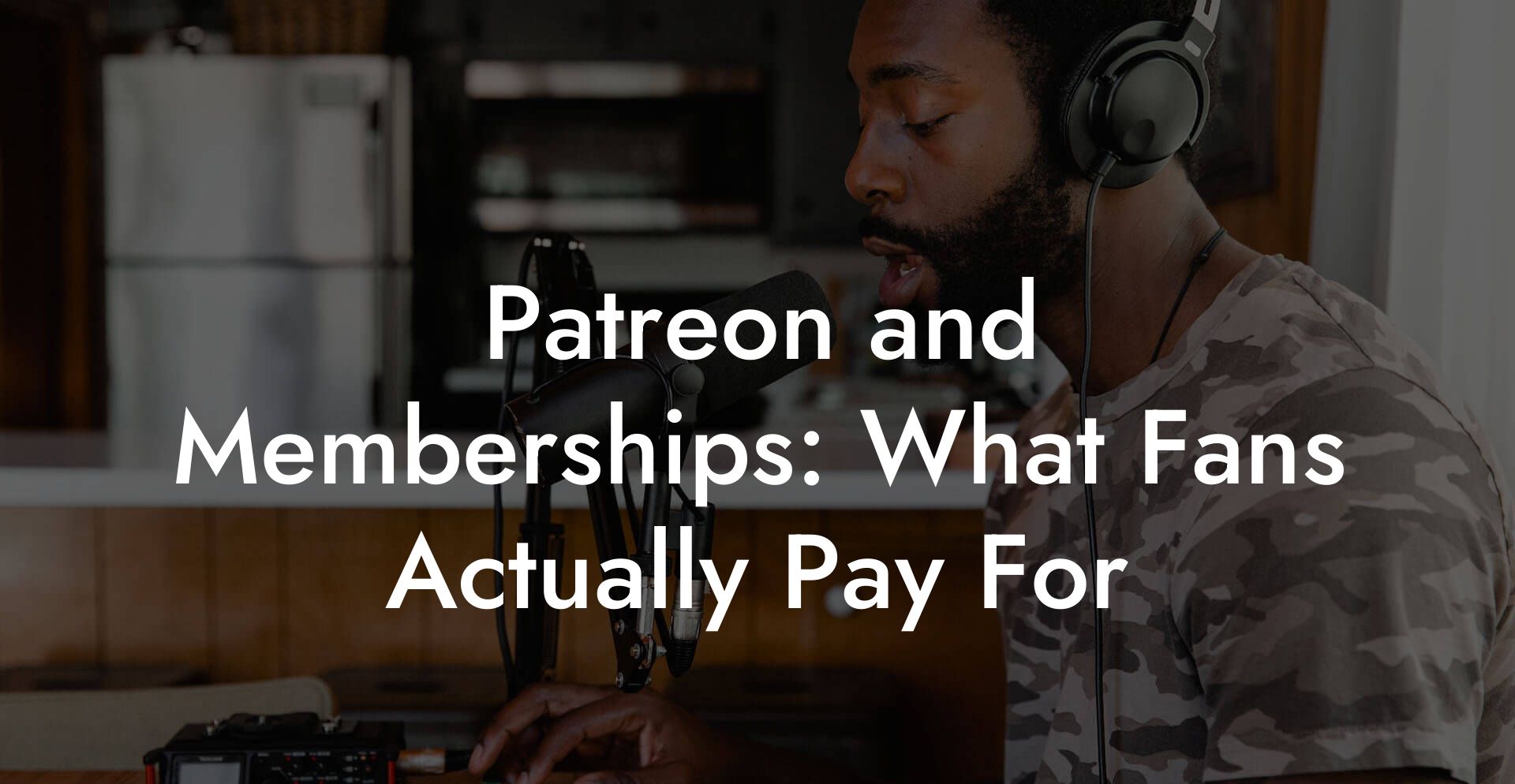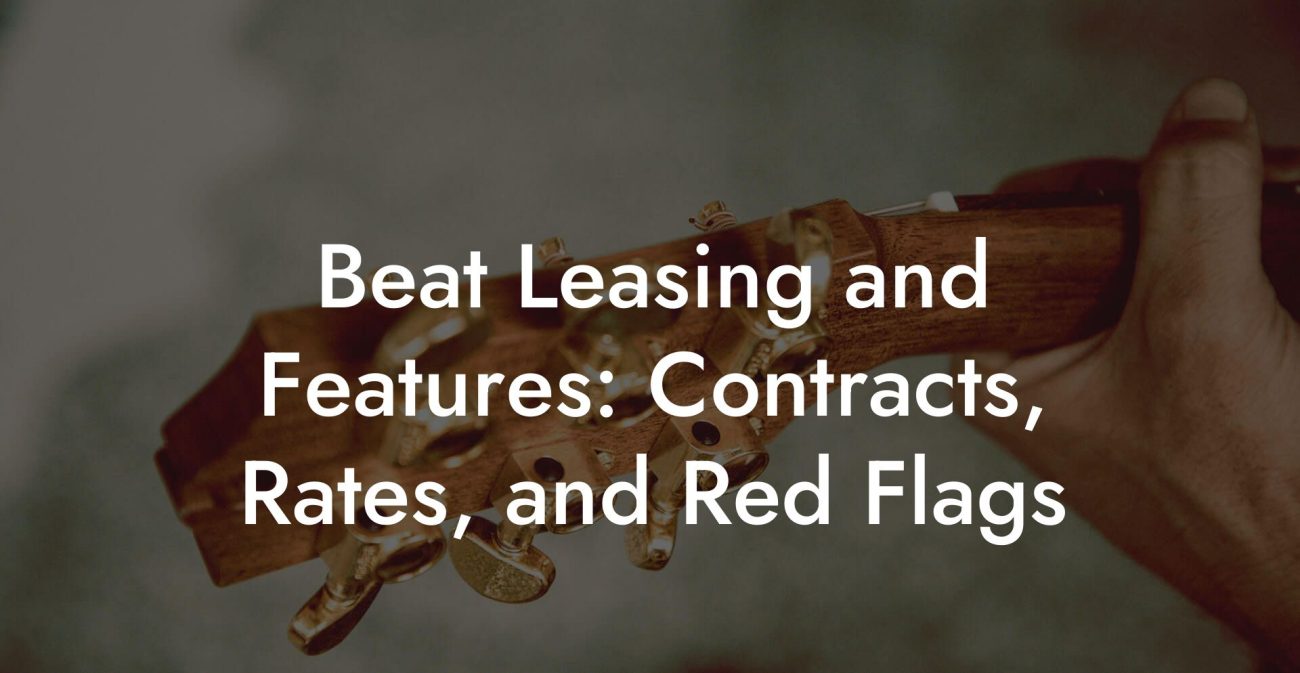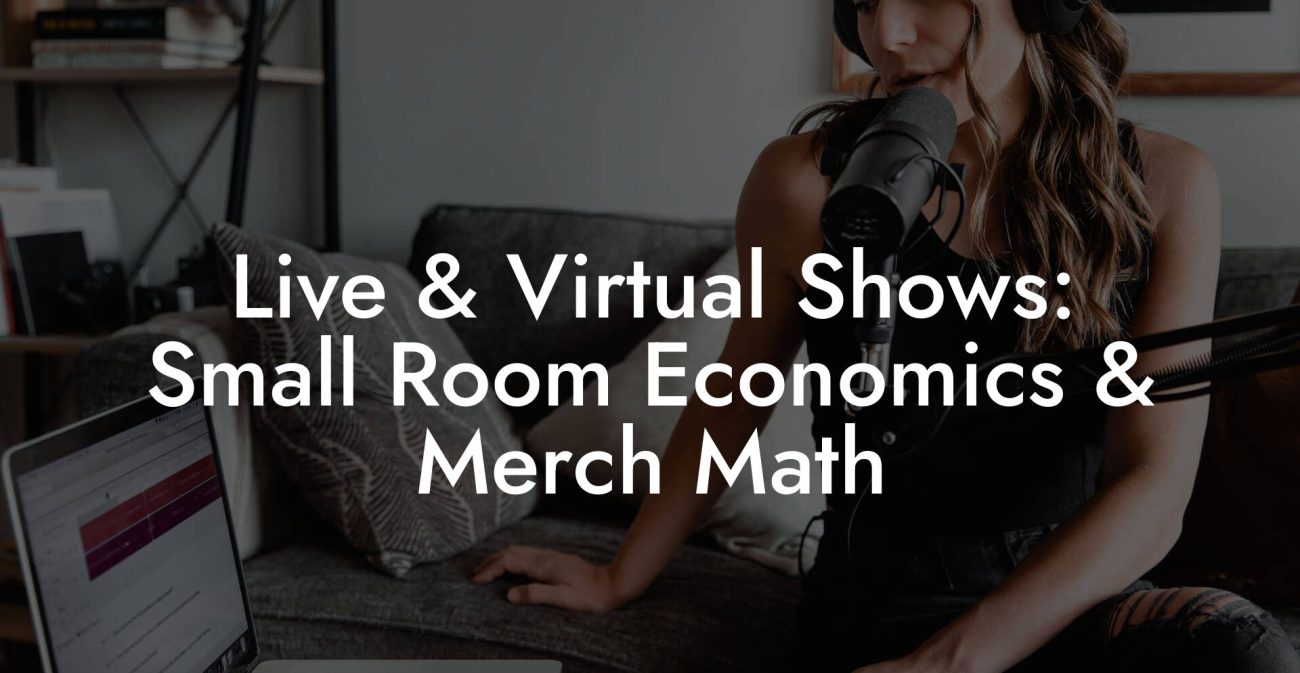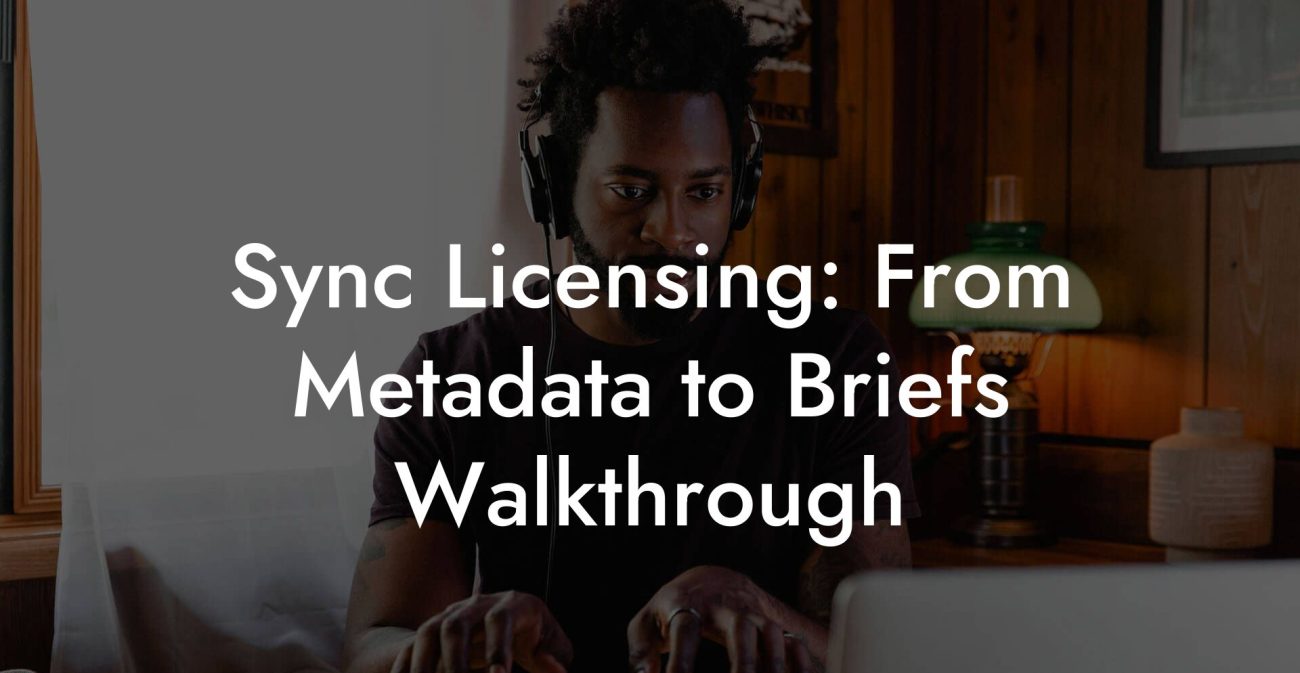Songwriting Advice
Patreon and Memberships: What Fans Actually Pay For

So you want fans to pay you on repeat. That is the dream. You want cash that is less chaotic than a one off streaming royalty and more reliable than an occasional merch drop. Patreon and membership platforms promise steady income in exchange for being slightly less mysterious. This guide tells you what fans actually pay for and how to build tiers, perks, and a delivery plan that feels fair to your fans and sustainable for you.
Quick Interruption: Ever wondered how huge artists end up fighting for their own songs? The answer is in the fine print. Learn the lines that protect you. Own your masters. Keep royalties. Keep playing shows without moving back in with Mom. Find out more →
Quick Links to Useful Sections
- Why memberships work for musicians
- What fans actually pay for
- 1 Belonging and identity
- 2 Access and early content
- 3 Education and behind the scenes
- 4 Exclusives and scarcity
- 5 Direct interaction and VIP experiences
- Designing tiers that make sense
- Tier 1 entry level
- Tier 2 core supporter
- Tier 3 super fan
- Tier 4 VIP and experiences
- Perk templates that actually convert
- Entry level copy
- Core supporter copy
- Super fan copy
- VIP copy
- Delivery cadence and content planning
- Retention not just acquisition
- How to price with confidence
- Platform choices and trade offs
- Promoting memberships without feeling slimy
- Legal and tax basics
- Scaling without burning out
- Examples of successful membership offers
- Action plan to launch your membership this month
- Common mistakes and how to avoid them
- FAQ about Patreon and memberships
Everything here is written for artists who care about their art and also need rent money. Expect blunt logic, real life examples, pricing experiments, and templates you can copy. We explain every acronym so you sound smart in DMs and at meetings. We also give small scripts you can paste into your posts so you can stop staring at the blinking cursor and start getting paid.
Why memberships work for musicians
Membership income is not magic. Fans pay for value plus emotional connection. A membership converts people who value you enough to exchange monthly cash for ongoing access, early drops, and a feeling of belonging. It compresses the relationship into a predictable stream of support.
- Predictable income makes planning shows, studio time, and merch runs simpler.
- Deeper relationships build sustainable core fans who stream, share, and show up at shows.
- Creative freedom comes when you are not forced to chase algorithms for every release.
Example real life scenario
Emma is an indie singer who played small shows and sold a few shirts. She launches a membership with 150 fans paying an average of 7 dollars per month. That is 1050 dollars per month before platform fees and taxes. Emma uses the money to book a midweek studio day, deliver exclusive demos to her members, and hire a mixing engineer for two songs a month. She keeps her public release schedule steady while her members get early versions and behind the scenes content. The members feel like insiders and Emma stays fed.
What fans actually pay for
Fans do not pay for vague access to your soul. They pay for specific things that satisfy curiosity, status, utility, or belonging. Break perks into five emotional categories and design at least one perk per tier that hits each category.
1 Belonging and identity
People love feeling like they are part of a group. Memberships let fans say I am one of the few who backed them before the world noticed. These perks are cheap to deliver and high in perceived value.
- Access to a private chat community like Discord where other members can hang out
- Member only badges on your posts so they visibly stand out
- Early invites to ticket presales or secret shows
Relatable example
Think of it like a friend group chat. Being in it is the point. It does not have to be manic activity. A steady thread of your life and occasional exclusive photos keeps people feeling included.
2 Access and early content
Fans will happily pay to hear a song before the rest of the world does. Early access gives real utility to superfans and makes them feel influential.
- Early release of singles and demos
- Pre release livestream listening parties where members can comment live
- Early merch drops and limited pressings reserved for members
Real life twist
Release version A of a song to members and ask for feedback. If you use a small idea from their feedback in the final public release, mention the member by name in credits. That single small credit can boost loyalty and create a sense that membership actually shapes the art.
3 Education and behind the scenes
Musicians can sell knowledge. Producers, songwriters, and multi instrumentalists have skills members want to learn. This is a higher ticket item for serious fans who want to improve or simply to see how the sausage is made.
- Tutorial videos on songwriting, production, and vocal technique
- Stems and project files so members can remix your songs
- Live studio sessions with Q and A
Acronym explained
STEMS are separate audio tracks that make up a song. For example you might deliver the vocal stem, the guitar stem, and the drum stem. Fans who remix songs want stems because it lets them rearrange and repurpose your work.
4 Exclusives and scarcity
Limited physical items and exclusive songs create urgency. People pay when they fear missing out and when the item has collectible value.
- Limited edition vinyl pressings reserved for members only
- Member only singles that do not go to streaming services
- Physical art, handwritten lyrics, or signed postcards sent annually
Keep scarcity honest. If you promise limited numbers then do not restock. If a release becomes wildly popular, offer a public version later but keep the member version unique by adding a bonus track or special packaging.
5 Direct interaction and VIP experiences
Fans will pay for time. This is the most expensive and logistically heavy perk. Keep the scale small and the experience real.
- Quarterly video calls limited to a handful of members
- One on one coaching calls for songwriting or career questions
- Meet and greets at shows or private mini shows for top tier members
Relatable example
One of my friends offered a three member monthly session where each member got 30 minutes of one on one time. That was pricey but sell out fast because fans value focused time over generic content.
Designing tiers that make sense
People hate confusion when deciding to pay. Keep it simple. Offer three core tiers and then one ultra exclusive tier if you like. Too many tiers create decision paralysis.
Tier 1 entry level
Price range example: 2 to 5 dollars per month
Include things like early access to content, a private feed and a badge. Entry level should be easy to buy impulsively. It is how casual fans become regular supporters.
Tier 2 core supporter
Price range example: 7 to 15 dollars per month
This is where most of your members will live. Include monthly exclusives like a demo, a behind the scenes clip, and access to the community. Add occasional perks with real perceived value like a yearly signed postcard.
Tier 3 super fan
Price range example: 25 to 50 dollars per month
Include access to stems, downloadable project files, monthly livestreams with Q and A, and priority merch access. This tier should feel like a membership that could be a second hobby for the fan.
Tier 4 VIP and experiences
Price range example: 100 dollars and up per month or as an annual fee
Offer one on one video calls, private performances, exclusive merch bundles, or co writing credits limited to a few members. Keep this tier tiny. It is a relationship builder more than a volume driver.
Pricing psychology explained
Anchor the middle tier by listing the most appealing tier in the center. Anchoring is a cognitive trick where you set a reference price so everything else feels reasonable. You can also offer annual billing at a small discount to lock in revenue. People who pay annually reduce churn and give you breathing room for projects.
Perk templates that actually convert
Below are copy templates and delivery schedules you can paste into your membership page. Use plain language. Explain the frequency and the format. People pay for predictability and clarity. Do not punish them with vague promises.
Entry level copy
Join the crew for 3 dollars per month and get early access to songs, a member only feed with behind the scenes photos, and a badge to show you backed me early. New members get a private thank you video in the first month.
Core supporter copy
For 10 dollars per month you get everything in the entry tier plus monthly behind the scenes videos, exclusive demos you can download, and access to our member only Discord. You also get first dibs on ticket presales and a yearly signed postcard.
Super fan copy
At 30 dollars per month you get the full experience. Monthly livestream listening sessions where you can ask questions, the full stems package for one song per month, and a quarterly group Q and A where we mix and critique songs together.
VIP copy
VIP members pay 150 dollars per month or a yearly option. You get a 45 minute one on one call each quarter, a signed limited edition vinyl each year, and a credit on one track per year. Memberships are limited to a small group to keep calls meaningful.
Delivery cadence and content planning
Consistency matters more than loudness. Pick a schedule you can maintain and tell members exactly what to expect. If you say monthly then deliver monthly. If you say weekly then do not miss.
- Weekly micro content like clips, photos, and updates keeps the feed alive
- Monthly substantial content such as a demo, a video, or a livestream gives members value
- Quarterly big items like signed merch or private shows make members feel rewarded
Example calendar
- Week one Update post plus a behind the scenes photo
- Week two Micro video on the songwriting process
- Week three Early release of a demo with download link
- Week four Member only livestream or Q and A
- Quarterly Send signed postcards to members who have been active for three months
Relatable scenario
Do not try to record a full studio album for members every month. That is exhausting and sets you up to fail. Instead record small valuable moments such as a raw demo, a quick tutorial on a technique, or a candid update about tour planning. Those small moments feel intimate and cost you less time.
Retention not just acquisition
Getting members is fun. Keeping them is where the money hides. Average revenue per user or ARPU is your monthly average per paying member. Lifetime value or LTV is the expected total revenue from a member until they churn. Small improvements in churn yield big gains in income.
Explain the acronyms
- ARPU stands for Average Revenue Per User. It is the average monthly income from each member.
- LTV stands for Lifetime Value. It is how much money you can expect to earn from a single member until they cancel.
Simple retention tactics
- Welcome new members with a personal message or a short video within 72 hours
- Keep content flowing in the first 30 days to create habit
- Offer a small loyalty reward at three months and at twelve months
- Ask for feedback using one focused question and then act on it
Churn reduction trick
When someone cancels, send a short exit survey with one question. Offer a small discount for a month to try to keep them if they indicate price is the reason. If they say they are not consuming content, ask what would make the membership worth their time. Small personalization can bring many people back.
How to price with confidence
Pricing is not guesswork. Test and iterate. You will lose some sales early when you are learning which perks resonate. Keep the tests controlled and the changes transparent to members.
- Start with a simple three tier model and launch
- After one month evaluate which tier fills fastest and which has highest churn
- Adjust content or price rather than adding noisy perks
- Consider annual billing at a 10 to 20 percent discount to encourage commitment
Pricing experiments you can run
- Raise the middle tier price by a small amount and measure conversion for 30 days
- Introduce a limited time bundle for new members for the first month and evaluate retention
- Add a single high value experience to the top tier and see if it sells out
Platform choices and trade offs
There are many membership platforms. Patreon is the most known but others exist such as Memberful, Ko Fi, Bandcamp subscriptions, and platform integrated options like YouTube channel memberships. Each has pros and cons around fees, payment methods, and audience discoverability.
- Patreon offers discovery tools and a built in audience but takes fees for processing and platform usage
- Memberful integrates with your website and gives more brand control but may need technical setup
- Bandcamp subscriptions are great for music focused offerings and built in purchasing for fans who already buy music
- YouTube and Twitch memberships are ideal if your main audience is already on those platforms and you live stream often
Fee explanation
Platform fees include the platform cut and payment processing fees. Payment processors charge a percentage and sometimes a small flat fee per transaction. You should always estimate net income after fees and taxes when planning your pricing. Also consider VAT rules if you sell to fans in the European Union. VAT stands for Value Added Tax and is charged on digital goods in many countries.
Promoting memberships without feeling slimy
Ask your fans to support you like you would ask a friend for a favor. Be honest and specific. Show what the money will buy and the impact it will have on your art. People respond to tangible goals and milestones.
Promotion tactics that feel good
- Share a specific goal like funding a studio day. Break down the costs so supporters see the math.
- Use short video messages to explain new perks. Video builds trust quickly.
- Offer a limited time incentive such as a special postcard for the first 50 members who join
- Feature member testimonials and stories about how membership improved your creative output
Script you can use
Hey friends I am launching a membership to help cover studio time and make more behind the scenes content. For 5 dollars a month you get early access to new songs and a private place to hang out. If you can join thank you. If you cannot share this post instead. Both help a lot.
Legal and tax basics
If this is serious income you need to treat it like a business. Keep records, set aside money for taxes, and understand the rules in your jurisdiction. If you sell physical goods you will handle shipping and possibly customs. If you accept charitable donations that is a different set of rules entirely.
- Keep a separate bank account for business income
- Track monthly income and fees in a spreadsheet or accounting app
- Set aside an estimated percentage for taxes and social charges depending on where you live
- Issue receipts when required and consult a tax professional if your income grows
Scaling without burning out
Growth is great until it consumes your life. Scale slowly and automate where possible. Use templates, scheduled posts, and community moderation to keep day to day work manageable.
- Automate welcome messages and initial deliverables using platform tools
- Hire a community moderator when the group becomes large so you can focus on content
- Batch create content so you have a buffer for busy weeks
- Set member expectations about response times to questions and cut yourself slack
Real life boundary example
An artist I know offered members daily access to a group chat and then crashed from constant messages. They adjusted expectations to three weekly posts and a monthly livestream. Members were surprisingly okay with that because the quality of interaction improved. People prefer meaningful contact to constant presence.
Examples of successful membership offers
Example 1 The songwriter
Monthly tiers 5, 12, 30 dollars. Entry level gets early songs and a post each week. Middle tier gets monthly unreleased demos and access to a small private chat. Top tier gets stems, monthly group critique, and a yearly signed lyric sheet. The songwriter uses income to fund monthly co write sessions and credits members in liner notes. Result stable income and tighter community.
Example 2 The producer
Monthly tiers 3, 10, 50 dollars. Entry level gets project updates and sample packs. Core tier gets monthly tutorial videos and access to sample libraries. Super tier gets monthly stems, project files, and a private one on one session each quarter. The producer sells stems to fans who make remixes and sometimes collaborates with members on paid projects.
Example 3 The touring band
Monthly tiers 4, 15, 100 dollars. Entry level gets early ticket access and tour updates. Core tier gets exclusive live recordings from each tour stop and a members only live stream. VIP tier gets a soundcheck pass or a private mini show. The band uses membership money to subsidize travel and to offer free tickets to local fans in need.
Action plan to launch your membership this month
- Decide on core promise. Write one sentence that explains why someone should pay you monthly.
- Pick three tiers and define one main perk per tier using the templates above.
- Set a consistent delivery schedule and create a simple 30 day content buffer.
- Write your membership page copy using human language and the scripts above.
- Plan a launch announcement with a short video and a goal such as funding a studio day.
- Track conversions and member feedback for the first three months and iterate.
Common mistakes and how to avoid them
- Too many perks with low value Fix by simplifying to three or four strong things people actually want.
- Over promising Fix by under promising and over delivering. It is easier to surprise people with extra than to be late on big promises.
- No clarity on frequency Fix by stating exactly when and how content will arrive.
- Ignoring the community Fix by showing up for one hour each week to engage and signal that you are present.
- Pricing without math Fix by calculating net income after fees and taxes and modeling expected member counts.
FAQ about Patreon and memberships
Is Patreon worth it for musicians
Patreon can be worth it if you have a group of fans who want deeper access and are willing to pay regularly. It is most effective when used to build closer relationships with your core fans and when the perks you offer are sustainable. If you only have a handful of followers then grow your audience first and use memberships as a second step.
What should I offer for entry level tiers
Offer simple high perceived value items such as early access to songs, behind the scenes photos, and a private feed. Entry level perks should be easy to create and maintain. Their purpose is to convert casual supporters into recurring supporters.
How do I price my tiers
Start simple with three tiers. Use an entry level price that is impulsive. Make the middle tier the best value and the most popular. Add a top tier for superfans who want experiences. Offer an annual billing option for a discount. Test and iterate once you have data.
How much content do I need to create
Create a sustainable cadence. A weekly quick update plus a monthly substantial item is a common approach. You do not need daily content. Members prefer quality and consistency over quantity.
Can I give members exclusive music that never goes public
Yes you can. Many artists release member only tracks. Be transparent about exclusivity. If a member only track becomes more popular than expected you can decide later to release a public version while keeping a special member version with extra content.
How do I keep members engaged without burning out
Batch create content, automate welcome messages, hire a moderator when the community grows, and set clear expectations about response times. Use polls to ask members what they want and then deliver the most requested items.
Do memberships replace streaming revenue
Memberships supplement streaming revenue. They give you a more reliable income stream but do not replace the scale of platform income once you reach large audiences. Think of memberships as a base of super supporters that helps you create work on your terms.
What legal issues should I know
Keep records for taxes, consider sales tax or VAT for digital and physical goods, and be clear about intellectual property rights if members get stems or project files. Consult a tax professional for country specific guidance.




